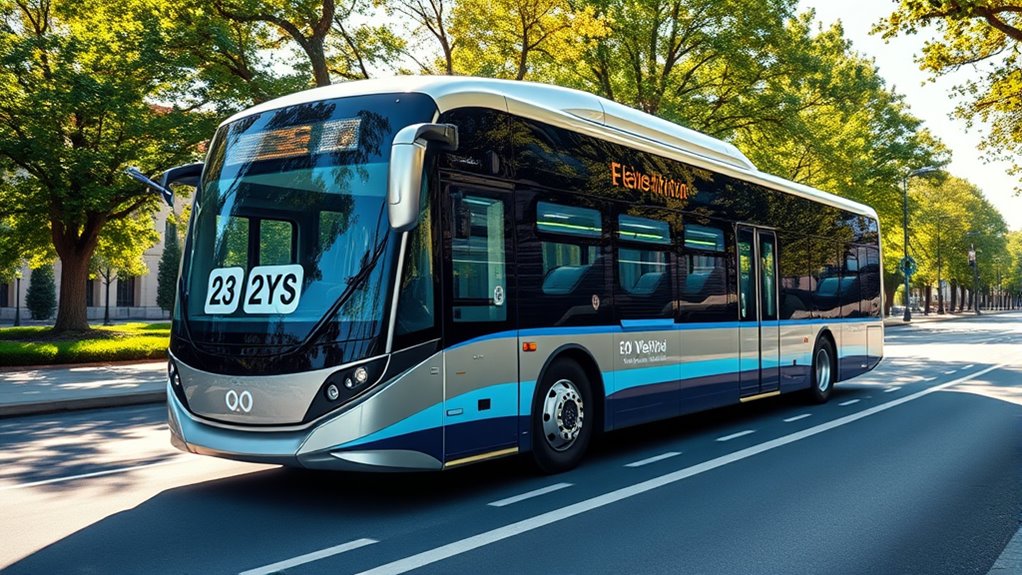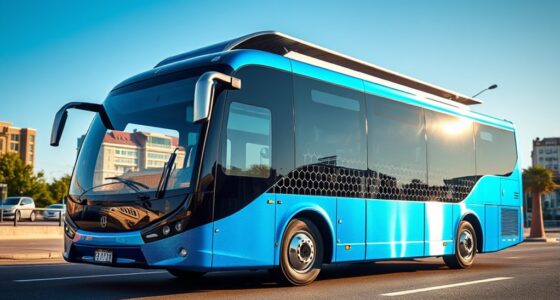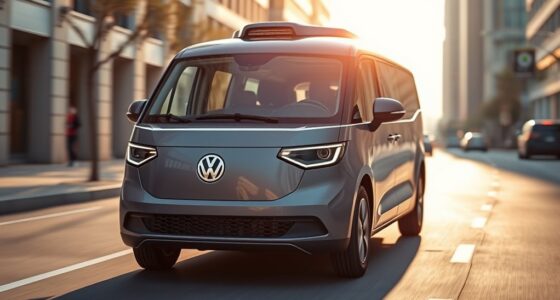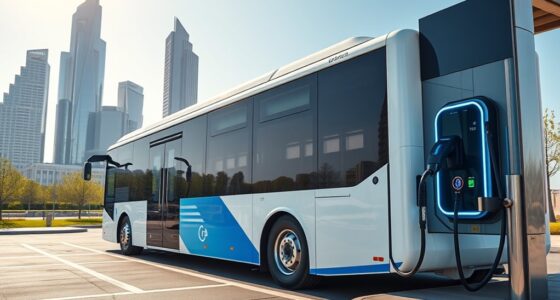Recent advancements have dramatically increased electric bus range and efficiency. Battery capacities have grown from 329 kWh to over 441 kWh, enabling buses to travel more than 320 km on a single charge. Energy efficiency has improved by around 20%, reducing energy consumption and operational costs. Smart AI-driven systems optimize routes and battery management, while fast-charging infrastructure minimizes downtime. Discover how these innovations shape sustainable transit solutions and what’s next for electric buses.
Key Takeaways
- Battery capacity has increased from 329 kWh in 2020 to 441 kWh in 2024, enabling longer ranges.
- Improved battery energy density allows buses to travel over 320 km on a single charge.
- Industry-wide energy efficiency has improved by 20%, reducing energy consumption per mile.
- AI-powered route planning and intelligent energy management optimize efficiency and battery lifespan.
- Rapid-charging stations and enhanced infrastructure support quick top-ups, minimizing downtime.

Recent technological advancements are transforming electric buses, substantially boosting their range and efficiency. These improvements are making electric transit more practical and attractive for cities and operators worldwide. Thanks to significant gains in battery technology, bus manufacturers can now produce models that travel farther on a single charge, reducing downtime and operational costs. For example, newer buses feature a typical range of 250 miles or more, a notable increase from earlier models.
Recent battery tech gains enable electric buses to travel 250+ miles per charge, reducing costs and boosting efficiency.
This progress stems from a rise in average battery capacity, which jumped from 329 kWh in 2020 to 441 kWh in 2024, enabling longer journeys without adding excessive weight or size. Such enhancements allow buses to cover more ground with fewer recharges, making electric options more suitable for both urban routes and intercity travel.
Battery energy density has improved markedly, allowing for longer ranges and shorter charging times. This means your electric bus can operate longer between charges, and downtime for recharging is minimized. The industry is also seeing a 20% improvement in energy efficiency over the past three years, translating into less energy consumption for the same distance traveled.
As a result, buses can now achieve longer ranges without necessarily increasing battery size, which keeps vehicle weight manageable and reduces costs. Manufacturers are developing diverse models to meet different operational needs, from short urban routes to longer intercity journeys, ensuring versatility across transit systems.
AI integration further enhances route planning and energy management, optimizing how and when buses recharge and operate. These intelligent systems help maximize efficiency, extend battery life, and reduce operational expenses. Urban transit agencies benefit from this technology by better managing fleets and ensuring smoother service.
Alongside technological progress, infrastructure development plays a critical role. Well-established charging networks, especially in North America and the Asia-Pacific region, support long-haul and intercity electric bus operations. Urban depots now prioritize rapid-charging stations, enabling quick top-ups that keep buses on the move. Increased government investments in charging infrastructure and policies that favor electric vehicles are accelerating adoption and making long-range buses more viable.
In terms of use cases, medium-sized buses are popular in city environments due to their maneuverability and capacity balance. Urban routes often favor buses with shorter ranges, thanks to shorter distances and frequent stops, but improved battery technology is making longer-range buses more feasible for intercity travel.
As these buses can now cover over 320 km on a single charge, operators can plan more flexible routes without the concern of frequent recharging. Additionally, battery technology improvements are contributing to faster charging times and increased durability, further supporting operational efficiency. Such advancements aren’t only reducing emissions and urban pollution but also lowering operational costs and increasing the lifespan of buses.
With continued innovation and supportive policies, electric buses are poised to become the backbone of sustainable transit systems worldwide.
Frequently Asked Questions
How Do Electric Buses Perform in Extreme Weather Conditions?
You’ll find that electric buses perform well in cold weather because their weight distribution improves stability and traction. Even at -25°F, they can complete routes with minimal range loss, though heating increases energy use.
To counteract this, you can use thermal management systems and route planning to optimize performance.
While extreme heat reduces efficiency, proper cooling and monitoring help keep your electric buses running smoothly.
What Are the Long-Term Maintenance Costs of Electric Buses?
You’re curious about the long-term maintenance costs of electric buses. Over their lifespan, these buses can save you over $125,000 in maintenance compared to diesel, thanks to fewer moving parts and regenerative braking.
While upfront costs and battery replacements are considerations, the overall savings, predictable schedules, and warranty coverage make electric buses a cost-effective choice for the long term.
Typically, electric buses offer a payback period of around five years.
How Does Battery Recycling Impact Environmental Sustainability?
Battery recycling greatly boosts environmental sustainability by preventing hazardous leaks into soil and water, reducing landfill waste, and conserving natural resources like lithium and cobalt.
It supports a circular economy, cuts greenhouse gas emissions, and minimizes the need for mining, which harms ecosystems.
What Are the Challenges in Deploying Fast-Charging Infrastructure?
Think of deploying fast-charging infrastructure as building a highway through a dense forest—you face many obstacles. You might strain the existing electrical grid, facing capacity limits and costly upgrades.
Finding the right spots for chargers is tricky, especially with depot space constraints. High costs and the need for specialized tech slow progress.
Without standard protocols, your chargers mightn’t work smoothly together, making the journey even more challenging.
How Do Electric Buses Compare to Hybrid Models in Efficiency?
You see, electric buses are more efficient than hybrid models because they convert electrical energy to motion more effectively, with higher miles per gallon equivalent.
They also recover energy better during braking and avoid fuel-related efficiency drops.
While hybrids can run longer without charging, electric buses perform exceptionally well in urban routes where charging stations are available.
Conclusion
These advancements in electric bus range and efficiency are truly changing the game. As technology keeps progressing, you’ll find yourself on the cutting edge of sustainable transportation, making a real difference. Don’t forget, every step forward is a leap toward a greener future. With innovations coming fast and furious, it’s clear that the road ahead is paved with promise. Keep your eyes open—you’re riding the wave of change, and the best is yet to come.









